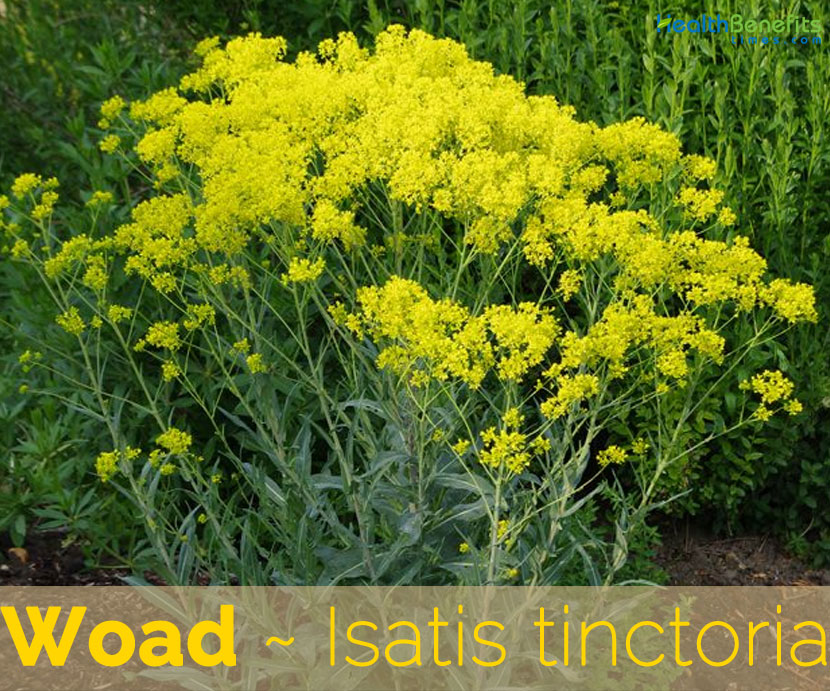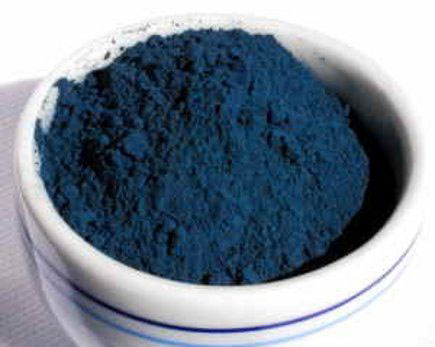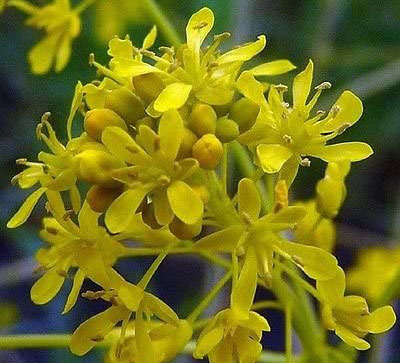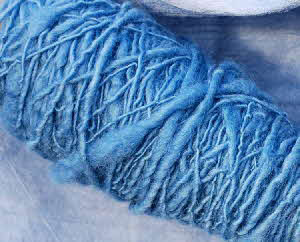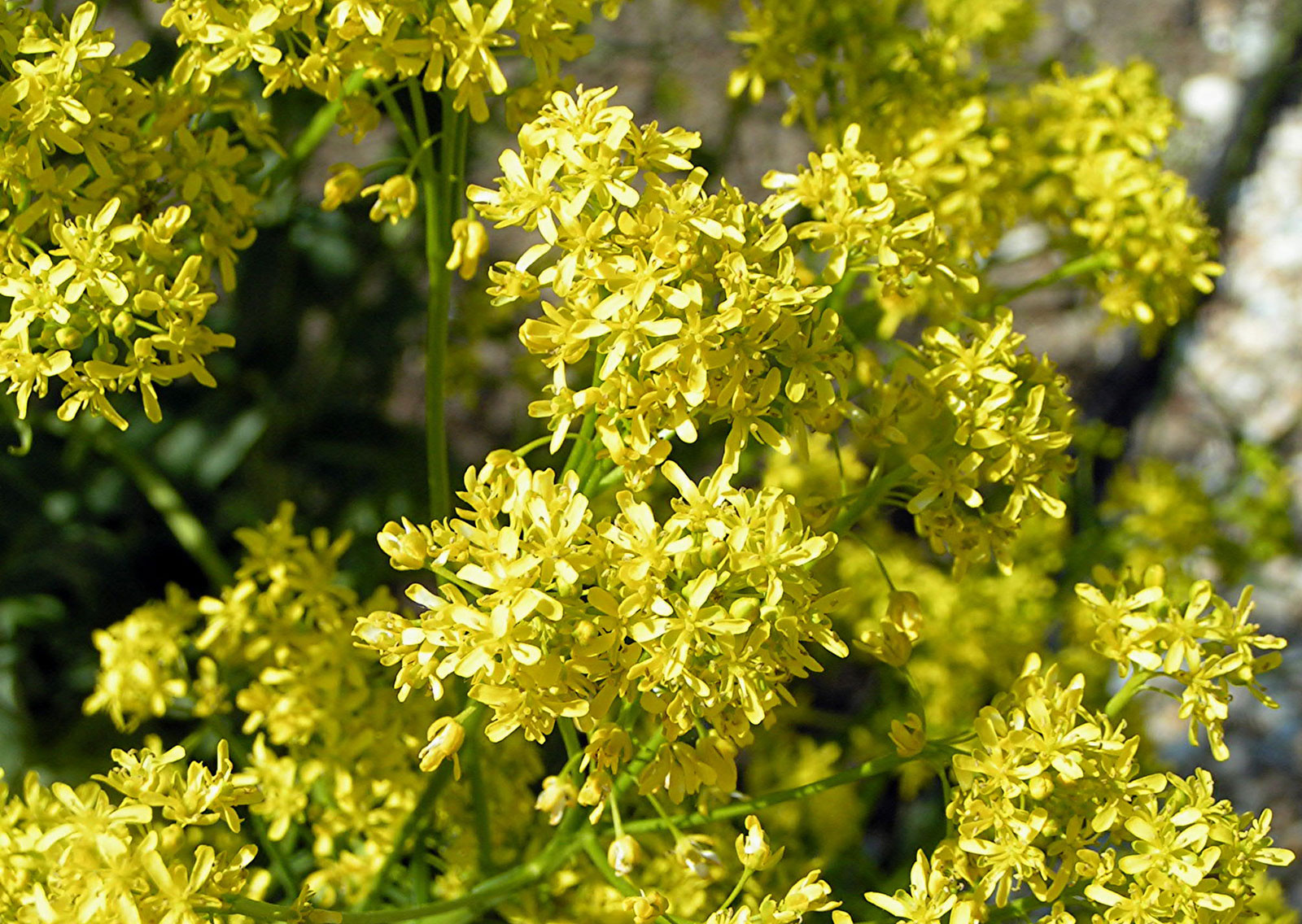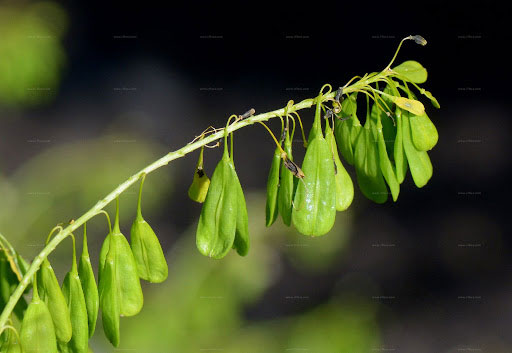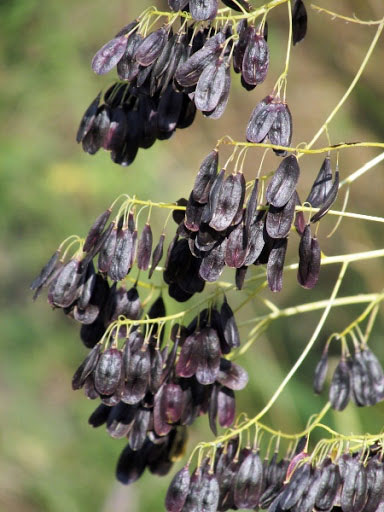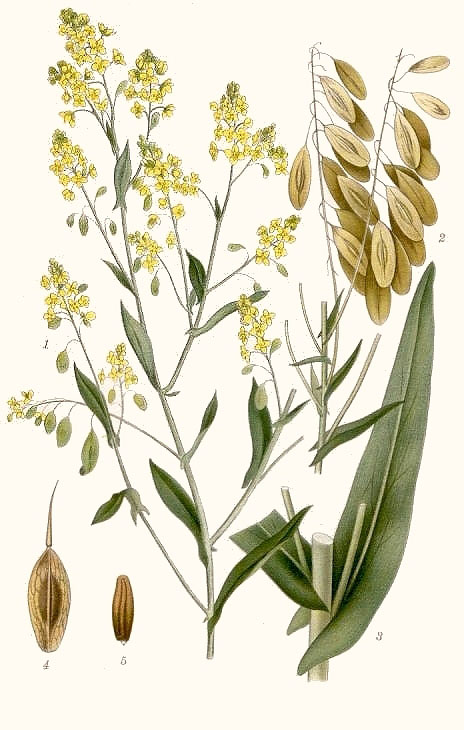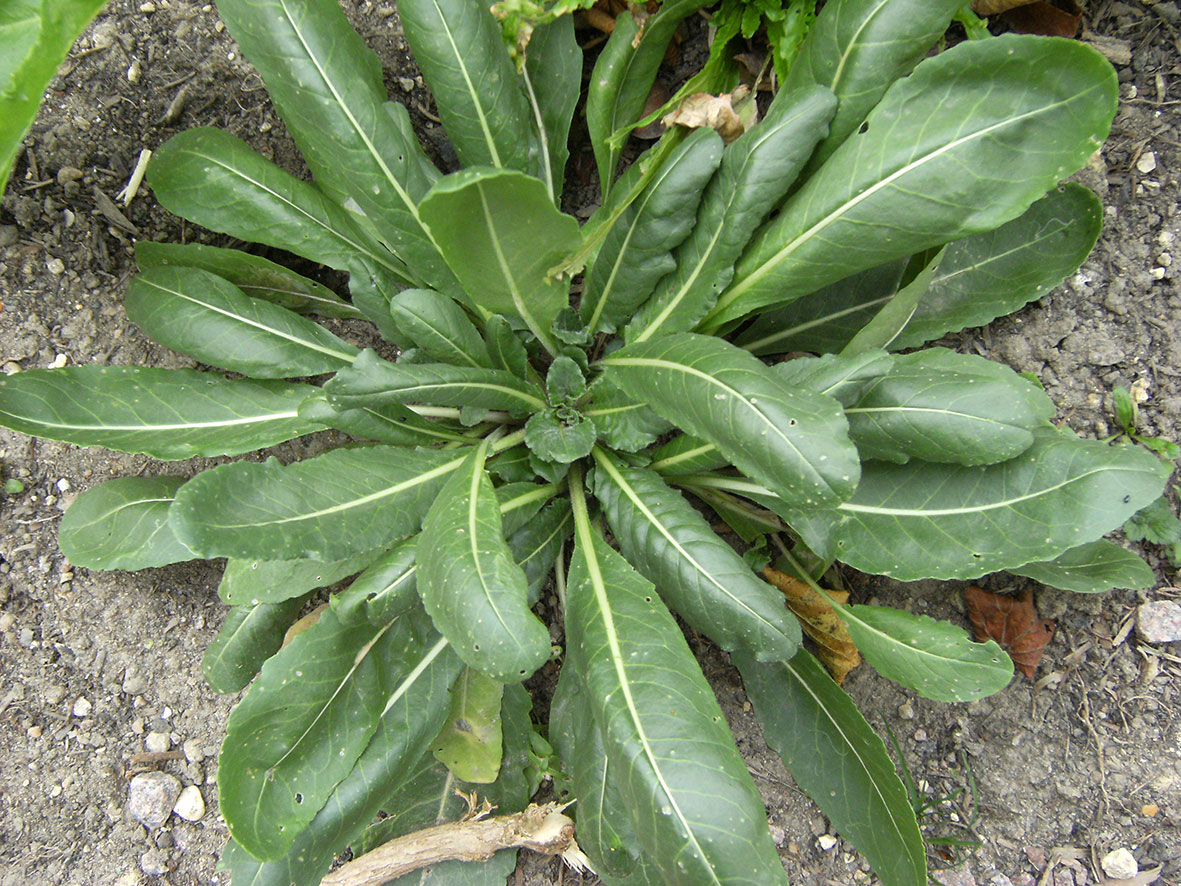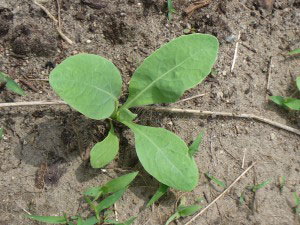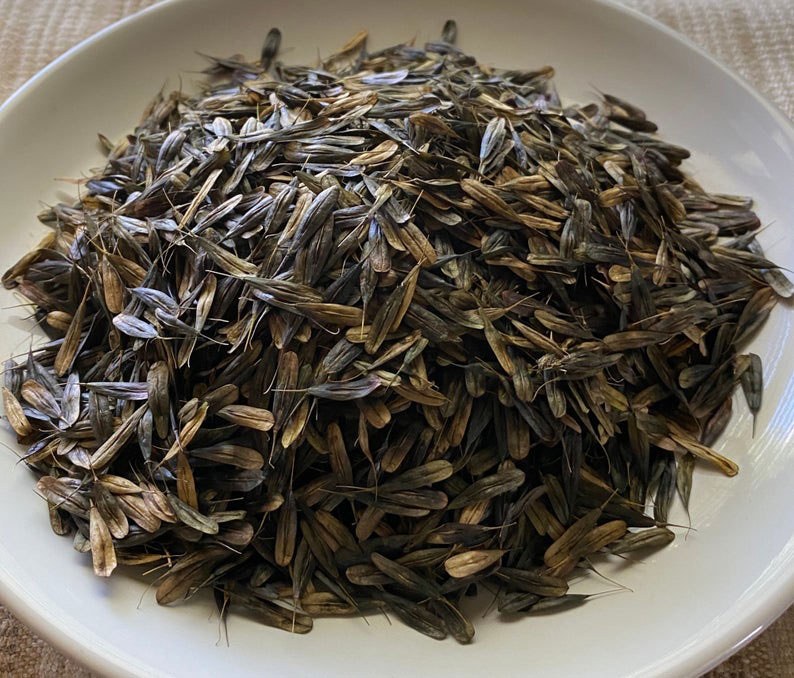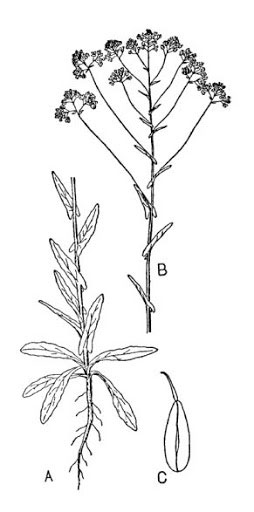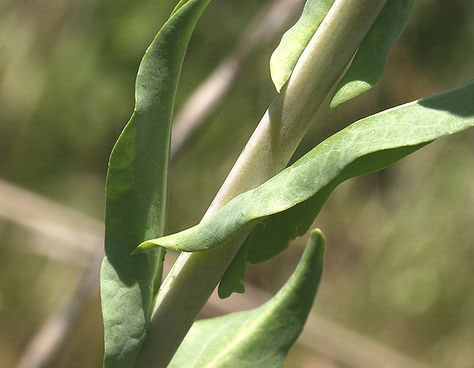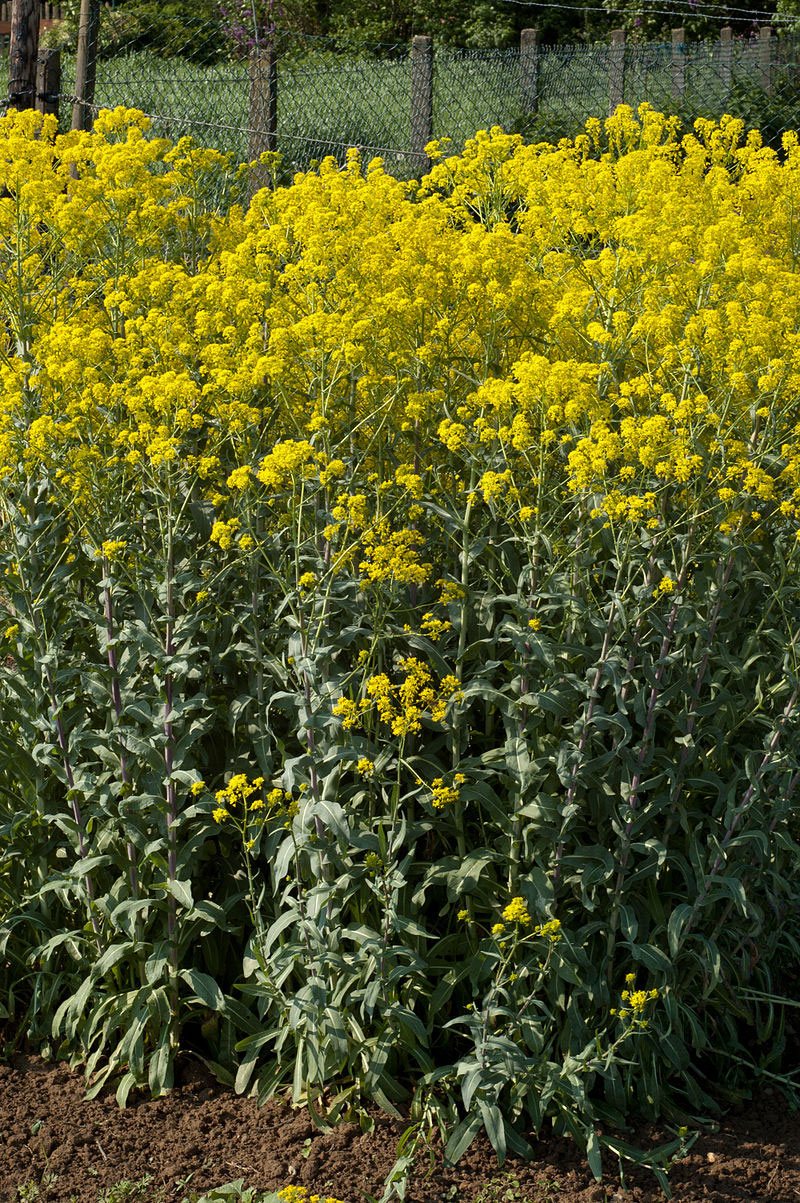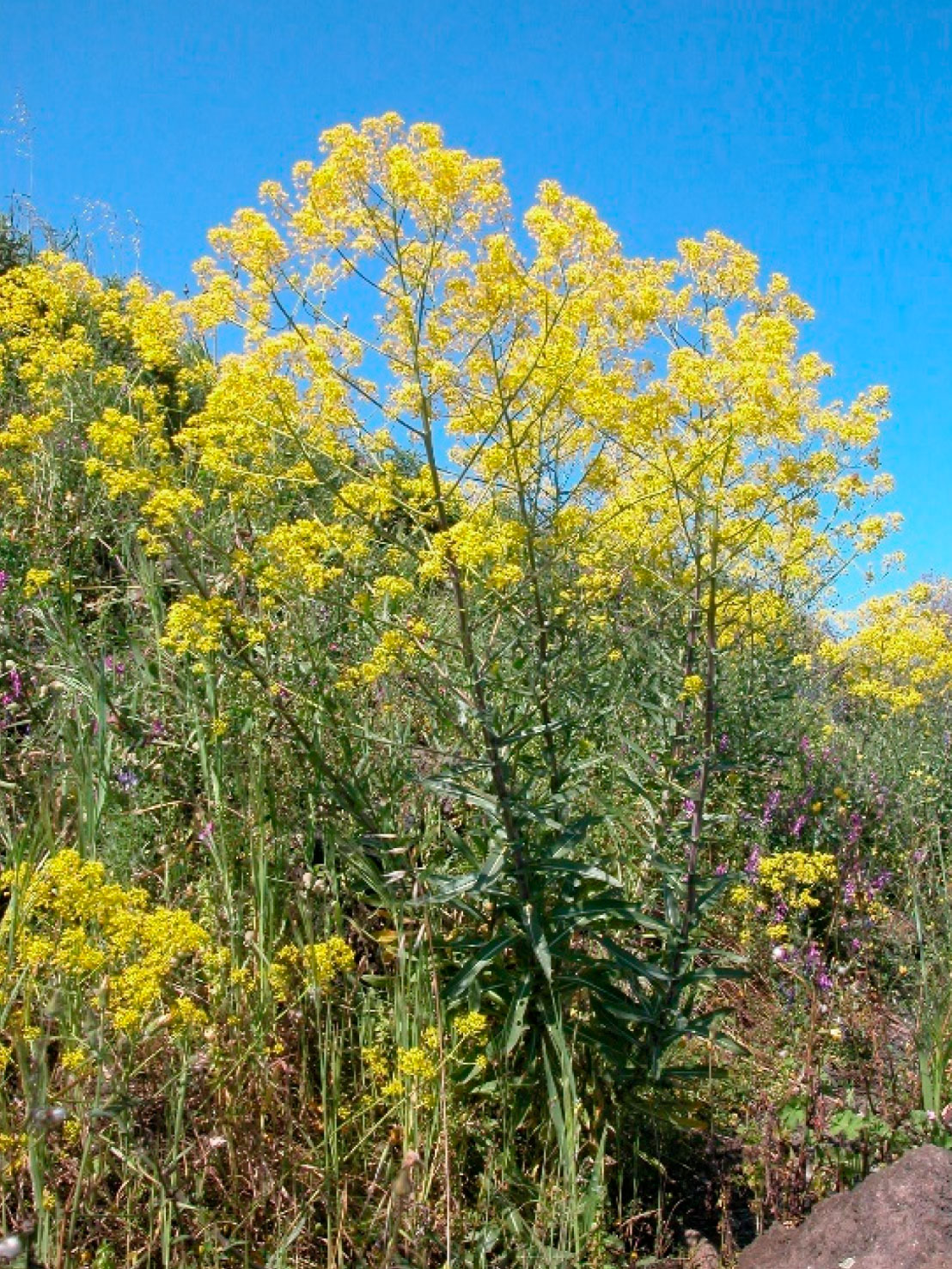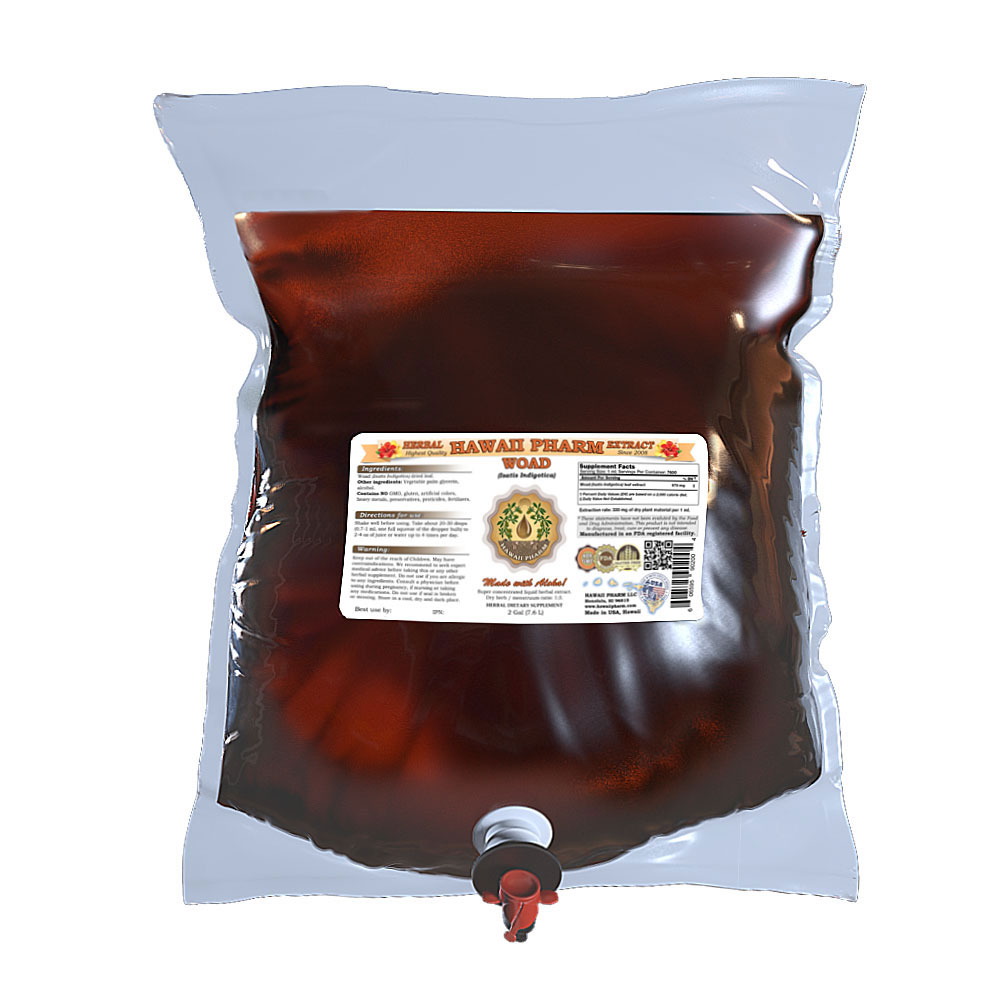Dyer’s woad, wade, woad, Asp-of-Jerusalem and glastum are some of the popular common names of the plant. Woad is a common name for this plant plus the name of the blue dye extracted from the leaves of the plant. Genus name is the classical Greek name for this plant. It was cultivated in Britain up to about 1930 for production of a blue vegetable dye. It is much less in demand today for commercial dye purposes because of the creation of synthetic dyes which have now taken its place, as well as the place of Indigofera tinctoria, as a main source of blue dye. Specific epithet from Latin means used in dyeing.
Woad Facts
| Woad Quick Facts | |
|---|---|
| Name: | Woad |
| Scientific Name: | Isatis tinctoria |
| Origin | Caucasus, Central Asia to Eastern Siberia and Western Asia |
| Colors | Green when young turning to deep blue to black at maturity |
| Shapes | Teardrop-shaped silicle that hangs from a small stalk, 6-10 mm long |
| Taste | Bitter, sweet, salty |
| Health benefits | Treats Parotitis, Helps Stop Diarrhea, Heals Aphthous Ulcers, Alleviates Tick Bite Symptoms, Disinfects Wounds, Treats Bone Infection |
| Name | Woad Plant |
|---|---|
| Scientific Name | Isatis tinctoria |
| Native | Steppe and desert zones of the Caucasus, Central Asia to Eastern Siberia and Western Asia but is now also found in South-Eastern and Central Europe and western North America |
| Common Names | Dyer’s woad, wade, woad, Asp-of-Jerusalem, glastum |
| Name in Other Languages | Afrikaans: Wede Albanian: Isatisi ngjyrues, izatis, woad Amharic: Weyo (ወዮ-) Arabic: Woad-wōd, wasamat alsabaghin (وسمة الصباغين) Armenian: Verats’nel (վերացնել) Azerbaijani: Yüklə, Boyaq çüyütotu Basque: Urdinbelar Bengali: Woad-wōd Bulgarian: Bagrilna sŭrpitsa (багрилна сърпица), sŭrpitsa (сърпица) Burmese: Nay (နေ) Catalan: Glast, Herba de sant felip, Herba del pastell, Pastell, Pastell de tintorers Chinese: Sōng lán (菘蓝), Da Qing Ye Cornish: Liwles Croatian: Bojadisarski vrbovnik, sivkasti vrbovnik, woad, Ličilarski vrbovnik Czech: Boryt barvířský, trápit, Farbovník oby Danish: Farve-vajd, woad, Klippe-ædelgran, Nobilis, Nordmannsgran Sibirisk ædelgran Dutch: Veverswede, wede, wevers wede, woad English: Dyer’s woad, wade, woad, Asp-of-Jerusalem, glastum Esperanto: Teksilo Estonian: Harilik sinerõigas, woad Filipino: Manligaw Finnish: Morsinko, värimorsinko, värimorsingon French: Guède, herbe de Saint Philippe, pastel, pastel blanchâtre, pastel des teinturiers, varède, teinturière Georgian: Gadat’virtva (გადატვირთვა) German: Deutscher Indigo, deutscher Issadig, Färberwaid, Färberwalt, Waid, Walt, woad Greek: Isatis vafikí (ίσατις βαφική), isátis (ισάτις) Gujarati: Kōciniyala (કોચિનિયલ) Hausa: Bakin ciki Hebrew: קוצינאלי Hindi: Kōṣinīla (कोषिनील) Hungarian: Festő csülleng, festőfű Icelandic: Litunarlukka, vaða Indonesian: Membongkar Irish: Woad Italian: Glasto commune, guado, pastello Japanese: Woad-wōd, Hosobataisei (ホソバタイセイ) Javanese: Nganggur Kannada: Woad-wōd Kazakh: Jüktew (жүктеу), Boyawlı ïsat, Boyawlı ïsat (Бояулы исат), bwyavlaa ayasat (بوياۋلى ىيسات) Korean: Wodeu (워드), daecheong Kurdish: Hilandin Lao: Old (ໂຫລດ) Latin: Propius Ambiorigem Latvian: Krasu mele, woad, Kr Lithuanian: Dažinė mėlžolė, vade Macedonian: Prebrišete (пребришете) Malagasy: Woad Malay: Memuatkan Malayalam: Woad-wōd Maltese : Sqaq Marathi: Vūḍa (वूड) Mongolian: Achikh (ачих) Nepali: Haḍabaḍyō (हडबड्यो) Norwegian: Vaid, woad Occitan: Jaunello, Mes-de-mai, Pastèl Oriya: ବୁଣା Pashto: وډ Persian: بارگیری Polish: Urzet barwierski, urzeł barwierski, woad Portuguese: Glasto, pastel-dos-tintureiros, woad, pastel Punjabi : Haphaṛā (ਹਫੜਾ) Romanian: Drobușor Russian: vayda krasylʹnaya (вайда красильная), vajda (вайда) Serbian: obichni sach (обични сач), Sach (сач), sinj (сињ), sinji vrbovnik (сињи врбовник), voad (воад) Sindhi: لوڊ ڪريو Sinhala: Woad-wōd Slovenian: Vata Slovak: Boryt farbiarsky, farbovník obyčajný Spanish: Gualda, hierba de los tintoreros, hierba pastel, isátide, Glasto, hierba de San Felipe, noiglo, woad Sundanese: Ngabantingkeun Swedish: Vejde, Berggran, Kaskadgran, Nordmannsgran, Pichtagran, Vejde, Värimorsinko, Tajik: Vod (вод) Tamil: Woad-wōd Telugu: Woad-wōd Thai: Wod cems̄̒ (โวดเจมส์) Turkish: Civitotu Ukrainian: vajda villiarsova (вайда віллярсова), vayda polʹova (вайда польова), vayda farbuvalʹna (вайда фарбувальна), vata (вата) Urdu: بیدار Uzbek: Yuklamoq Vietnamese: Tải Walloon: Waisse Welsh: llwyth, Llysiau lliw Zulu: Woow |
| Plant Growth Habit | Winter biennial or a short-lived, usually monocarpic, perennial |
| Growing Climates | Cliffs, cornfields, often on chalky soils, roadsides, rangelands, open forests, railroad right-of-ways, fields, pastures, grain and alfalfa fields, rangeland, especially big sagebrush, sagebrush hillsides, prairies, waste areas |
| Plant Size | 1-4 ft. (0.3-1.2 m) tall |
| Root | fleshy and conical in shape, measuring about 2 cm to 3 cm across and about 20 cm to 30 cm in length. The main roots are yellow on the soil surface and have small stripes along with some petite fibrous roots |
| Stem | Upper part abundantly branching, glabrous, bluish green |
| Leaf | Rosette leaves are widest near the tip and covered with soft hairs. Stem leaves usually lack hairs and teeth on the margins. |
| Flowering season | June to August |
| Flower | About 6 mm wide with petals about 3.5 mm long [31,32,33]. Flowers are borne in numerous, compound racemes forming a large, terminal panicle |
| Fruit Shape & Size | Teardrop-shaped silicle that hangs from a small stalk, 6-10 mm long. Silicles are black to purplish-black, narrowly oblong, winged, and blunt-tipped |
| Fruit Color | Green when young turning to deep blue to black at maturity |
| Propagation | By seed |
| Plant Parts Used | Root, leaf |
| Seed | Dull brownish yellow seeds are cylindrical and weigh 3.9 mg and grooved into two unequal halves |
| Taste | Bitter, sweet, salty |
| Season | August to September |
| Health Benefits |
|
Plant Description
Woad is a winter biennial or a short-lived, usually monocarpic, perennial plant that normally grows about 1-4 ft. (0.3-1.2 m) tall. It typically grows in the first year as a large-tap rooted basal rosette to 12 inches tall, with branched, alternate-leaved flowering spikes rising above the basal rosette in the second year to 2-4 feet tall. The plant is found growing in cliffs, cornfields, often on chalky soils, roadsides, rangelands, open forests, railroad right-of-ways, fields, pastures, grain and alfalfa fields, rangeland, especially big sagebrush, sagebrush hillsides, prairies and waste areas. Roots are fleshy and conical in shape, measuring about 2 – 3 cm across and about 20 – 30 cm in length. The main roots are yellow on the soil surface and have small stripes along with some petite fibrous roots. It can grow more than five feet deep and smaller lateral roots that spread outwards near the surface. Upper part of the stem is abundantly branching, glabrous and bluish green.
Leaves
Rosette leaves and stem leaves of dyer’s woad differ slightly in morphology. Rosette leaves (basal leaves) grow up to seven inches (18 cm) long, are broadest near the tip and taper to a point at the base, have small-rounded teeth (crenulate), are ciliate and pubescent with simple hairs, and have a short petiole. Stem leaves have no petiole (sessile), have auricles that clasp the stem, the margins are mostly entire, and they are without hairs (glabrous). Stem leaves are alternate along the stem. All leaves have a prominent cream colored mid-rib extending the entire length of the leaf, and a bluish-green color. The leaf color and prominent mid-rib are good identifying characteristics of dyer’s woad.
Flowers
Flowers of dyer’s woad are bright yellow. Like all mustard flowers, they have four sepals (about 0.14 inches or 3.5 mm long), four petals, six stamens; two of which are shorter than the other four (tetradynamous). There are many flowers on much-compounded racemes that reach one to three feet (0.3 to 1.0 m) in height. Multiple floral stems per plant is common for dyer’s woad, and the combination of multiple stems with many branches bearing many bright yellow flowers gives dyer’s woad plants a showy appearance. The length of time from the initiation of flower stem growth to seed set is about eight weeks. Flowering normally takes place in between June to August.
Fruits
Fertile flowers are followed by produces a teardrop-shaped silicle that hangs from a small stalk, 6-10 mm long. Silicles are black to purplish-black, narrowly oblong, winged, and blunt-tipped, flattened, 0.4 in. (0.9 cm) long, 0.25 in. (0.6 cm) wide, and lack a septum. The style is lacking.
Seeds are mostly single, but occasionally a second seed is produced but is not viable. The dull brownish yellow seeds are cylindrical and weigh 3.9 mg and grooved into two unequal halves. Plants may produce 350 to 500 seeds each, but selected plants have been known to produce more than 10,000 seeds in one year.
Health benefits of Woad
Let’s take a look at some of the health benefits that are related with woad:
1. Treats Parotitis
Parotitis is characterized by the inflammation of the parotid gland, which is a main salivary gland. When you have mumps, one of the problems related with it is parotitis. Woad possesses anti-inflammatory properties, and that is why its topical use can be very helpful to those who are suffering from parotitis.
2. Helps Stop Diarrhea
Woad is also occasionally used for putting an end to diarrhea. It does so by killing off bacteria in the gut that is causing the stools to be watery. However, woad is hardly taken orally most especially in strong doses because of its very strong astringent properties, which means it can cause the tissues to contract.
3. Heals Aphthous Ulcers
Medical doctors call them aphthous ulcers, but everybody else is calling them canker sores. Unlike cold sores that are due to the herpes simplex virus, canker sores are not transmissible and they do not appear on the lips. One of the traditional remedies for canker sores is woad, courtesy of its anti-inflammatory and anti-bacterial properties.
4. Alleviates Tick Bite Symptoms
One of the traditional uses of woad is for the treatment of tick bites. Some tick bites can actually cause further problems, such as headaches, nausea, muscle aches and pain, and flu-like symptoms. Usually, these associated symptoms appear a few days after the individual has been bitten by ticks.
5. Disinfects Wounds
Because of its astringent properties, woad is commonly used for treating minor wounds. Its ability to fight off bacteria makes it superb for warding off an infection. Woad is commonly used for treating skin problems in the form of infusion, and occasionally prepared as an ointment, too.
6. Treats Bone Infection
Woad is wonderful option for the treatment of bone infection, or what doctors call “osteomyelitis”. It is possible for a bone infection to be caused by bacteria and fungi. Since it is a very serious matter, it’s very important for a person who has it to strictly follow the treatment course provided by a specialist.
Traditional uses and benefits of Woad
- It is used externally as a plaster applied to the region of the spleen and as an ointment for ulcers, inflammation and to staunch bleeding.
- Leaves are antibacterial, anticancer, antiviral, astringent and febrifuge.
- It controls a wide range of pathogenic organisms, including viruses.
- It is used internally in the treatment of a wide range of disorders, including meningitis, encephalitis, mumps, influenza, erysipelas, heat rash etc.
- Leaves are also used medicinally, particularly in the treatment of high fevers and convulsions in children, coughing of blood and as a detoxifier in infections such as mumps.
- The root is antibacterial and anticancer.
- It is used in the treatment of fevers, pyogenic inflammation in influenza and meningitis, macula in acute infectious diseases, erysipelas, mumps and epidemic parotitis.
- Its antibacterial action is effective against Bacillus subtilis, haemolytic streptococcus, C. diphtheriae, E. coli, Bacillus typhi, B. paratyphi, Shigella dysenteriae, S. flexneri and Salmonella enteritidis.
- Both the leaves and the roots are used in the treatment of pneumonia.
- Root and the whole plant have anticancer properties whilst extracts of the plant have shown bactericidal properties.
- It boosts the Immune System and is used for treatment of Flu, Fever, Tonsillitis, Sore Throat, Herpes, Hepatitis and Skin Infections.
- The leaves are used both internally and externally. It also treats spasms in children.
- Traditional Chinese Medicine (TCM), Unani and Siddha have been using Isatis tinctoria for treating fever, oral sores, common colds, sore throat, mumps and even malignant tumors.
- Root of woad possesses antibiotic properties and works to boost the immune system.
- This herb has been traditionally used for treating flu, fever, red and swollen face, tonsillitis, sore throat, herpes, hepatitis, a number of skin infections and chickenpox.
- Woad leaves are also used for curing sore throat and fever, in addition to measles, meningitis, jaundice and specific hot skin rashes.
- Plaster prepared from woad leaves can be applied to the skin over the spleen, which is found on the left side of the body, to alleviate pains and also to eliminate the stiffness of the organ.
- Woad leaves are used internally for treating an assortment of health issues including influenza, encephalitis, erysipelas and others.
- Leaves are also used for treating spasms in children, in the form of a detoxifier to treat infectious conditions like mumps and cure coughing of blood.
- It is also used for treating epidemic parotitis, macula associated with severe contagious diseases and pyogenic inflammation associated with meningitis and influenza.
- It is also used for pharyngitis, laryngitis, erysipelas, carbuncle, to prevent hepatitis A, epidemic meningitis and inflammation.
Ayurvedic Health Benefits of Woad
- Sore Throat: Prepare a tea of Woad Leaf. Take it twice a day.
- Hepatitis: Boil the leaves for 10-15 minutes. Take two glasses three times a day.
- Japanese Encephalitis: Take 20 gram Anemarrhena, 40 gram Earthworm, 50 gram Woad, 40 gram Honeysuckle, 40 gram Scrophularia Ningpoensis and 100 gram Gypsum. Make a decoction with them. Drink 10 ml of it twice a day.
Usual dosage
Woad leaves offer a number of therapeutic benefits and, therefore, have different applications. The standard dosage of the leaves differs depending on the manner in which they are taken. The starting dosage of a dried Isatis leaf powder and concentrated dried leaf decoction are given below:
Dried leaf powder: The starting dosage is taking two to three grams daily.
Dried leaf decoction extract: The starting dose is anything between one and four grams daily.
Woad Anti-Viral Tincture
Ingredients
- 2 ounces dried Woad root, ground
- 4 ounces dried Woad leaf, ground
- ½ ounce piece of licorice root, ground (synergistic)
- 3 ½ cups water
- 1 tablespoon apple cider vinegar
- 1-inch piece of fresh ginger root, peeled and grated (synergistic)
- 1 cup 100 proof vodka
Directions
- In a 2 quart pot, mix the Isatis leaves and root and the licorice root with water and vinegar. Bring to a simmer. Cover the pot and simmer for 30 min. You’ll want a window open for ventilation when you do this. It smells strongly of cooked cabbage.
- Cool it rapidly to room temperature by placing the pot of water in a sink of cold water. Ensure that the pot doesn’t tip. If you’ve ever extracted the dye from Isatis leaves you’ll notice how similar the extraction of the medicinal alkaloids is to the extraction of the indigo precursors from the fresh leaves.
- When the mixture has cooled, pour both the decoction and the plant matter into a 1 quart, wide-mouth Mason jar with a lid. Add the fresh, grated ginger root. Add the alcohol. Cap tightly. Shake once a day.
- After 2 weeks, strain the liquid. Squeeze the spent herbs (marc) to extract as much of the liquid as possible. Compost the marc.
- Bottle the liquid in colored glass bottles and label.
Other Facts
- Woad is historically famous as a dye plant, having been used as body paint by the ancient Britons prior to the invasion of the Romans.
- A blue dye is obtained from the leaves by a complex process that involves fermenting the leaves and produces a foul stench.
- Dye is rarely used nowadays, having been replaced first by the tropical Indigofera tinctoria and more recently by synthetic substitutes.
- A very good quality green is obtained by mixing it with Dyer’s greenwood.
- Woad is also used to improve the color and quality of indigo, as well as to form a base for black dyes.
- Individual plants can produce on average 350 to 500 seeds.
- Plants are monocarpic, meaning they die after producing seed.
- The length of time from the initiation of flower stem growth to seed set is about eight weeks.
Prevention
Early recognition and immediate action are the most important control measures for Dyer’s Woad. Once detected, hand-pulling can be very effective. For best results, plants should be removed by flowering and the area checked once again 2-3 weeks later for any that might have been missed.6 Plants in flower should be bagged and burned when fully dry
Control
Grazing:
Dyer’s Woad is unpalatable but not toxic. Cattle refuse to graze it which enhances its spread in pastures or rangeland. Sheep readily consume the shoots up to flowering and thus may be suitable for control in these areas.
Mechanical:
Cultivation of the rosettes prior to bolting and flowering can eradicate newly established populations. Mowing is less effective due to the woody stems and the ability of the plants to resprout from the crown.
Chemical:
Dyer’s Woad in the U.S. has been efficiently controlled with the use of specific herbicides. Currently no selective herbicides are recorded for use on Dyers woad. Always check product labels to ensure the herbicide is registered for use on the target plant in Canada by the Pest Management Regulatory Agency. Always read and follow label directions. Consult your local Agricultural Fieldman or Certified Pesticide Dispenser for more information.
Biological:
Literature and field surveys have exposed several biological control candidates however testing was discontinued in 2008 due to lack of funding.
Precautions
- Long term use must be avoided as it may cause excessive bleeding.
- It may trigger an asthma attack or an allergic reaction in people who are allergic to Analgesic medicines.
- Avoid in case of Spleen and Stomach deficiency due to Cold.
References:
https://gd.eppo.int/taxon/ISATI
https://www.itis.gov/servlet/SingleRpt/SingleRpt?search_topic=TSN&search_value=23151#null
https://npgsweb.ars-grin.gov/gringlobal/taxonomydetail.aspx?id=20462
https://pfaf.org/user/Plant.aspx?LatinName=Isatis+tinctoria
https://www.cabi.org/isc/datasheet/28902
http://www.missouribotanicalgarden.org/PlantFinder/PlantFinderDetails.aspx?taxonid=278069
http://www.floracatalana.net/isatis-tinctoria-l-
https://plants.usda.gov/core/profile?symbol=ISTI
https://www.fs.fed.us/database/feis/plants/forb/isatin/all.html
https://en.wikipedia.org/wiki/Isatis_tinctoria
https://www.invasiveplantatlas.org/subject.html?sub=4587
https://www.nps.gov/articles/dyers-woad.htm
http://www.theplantlist.org/tpl/record/kew-2867046
https://botanical.com/botanical/mgmh/w/woad–28.html


